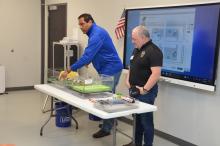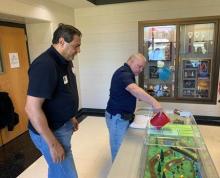
On a rainy day, when streets were flooding and muddy streams were flowing fast, a team of FEMA hazard mitigation specialists arrived at Taylor County High School to demonstrate the destructive power of water.
They traveled with a stormwater model designed to show students the basics of flooding. In miniature, it captured floodways and floodplains, homes and trees that could be swept away by floodwaters, a parking lot that could increase runoff, and a retention pond to help manage water flow and minimize risk.
All of this was contained in a clear acrylic case about 4 feet long, with tiny replicas of a river, trees, houses and sponges representing wetlands. A sieve-like panel at the top of the display allowed Jose Ruvira to pour in water to mimic rain while his partner, Emilio Perez, explained the effects.
On this day, the two specialists made their 30-minute demonstrations to 48 freshmen and seniors in two of Mrs. Lindsay Wayne’s agriculture classes.
Afterwards, they folded the portable model into a trunk on wheels, packed it into their SUV and headed for another Kentucky high school.

The stormwater model – officially known as the Ward’s Stormwater Floodplain Simulation System – was developed by Ward’s Science, which supplies educational materials for K-12 and college-level studies; Mark Walton, a hydrologist at the National Weather Service in Grand Rapids, Mich.; and Dave Chapman, a Michigan science teacher.
“We decided that it made sense to work with high school and junior high school students so that we could show them the dangers of storm water without getting too technical,” Perez said. He and his partner even made two Spanish-language presentations to students at Mayfield High School.
Altogether, the experts visited 13 schools across Kentucky, talking to more than 1,000 students, from Phelps High School in the mountainous northeast to Mayfield in West Kentucky.
All of the schools are located in areas that experience severe weather like the out-of-season tornadoes last December. Yet almost none of the students knew about floodplains. Perez said he believed the stormwater model information was especially important in the mountains of Pike County, where the team visited four high schools: Pikeville, Phelps, Shelby Valley and Pike County Central.
At Phelps, Perez recalled asking students how many lived near creeks. “About 85 percent of them raised their hands, and when we asked how many experienced flooding, about 50 percent raised their hands.” When one student asked, “What do I do?” Perez and Ruvira began explaining how to plan for a flood.
Perez and Ruvira suggested that teachers prepare and present a flood escape plan for the students and their families by visiting ready.gov/be-informed and downloading or requesting information.
Taking steps now to prepare for the next disaster may prevent property damage and save lives.

